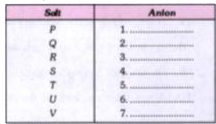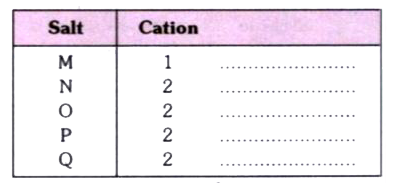X on treatment with sodium hydroxide followed by the addition of silver nitrate give white precipitate at room temperature which are soluble in NH4OH. X can be :
Chlorbenzene
Ethyl bromide
Benzyl chloride
Vinyl chloride
The correct Answer is:c
To solve the problem, we need to identify the compound X based on the given reactions and observations. Let's break it down step by step.
Step 1: Understand the Reaction
The problem states that compound X, when treated with sodium hydroxide (NaOH) and then silver nitrate (AgNO3), produces a white precipitate at room temperature. The white precipitate is soluble in ammonium hydroxide (NH4OH).
Step 2: Identify the White Precipitate
The white precipitate formed when silver nitrate is added to a solution containing chloride ions (Cl-) is silver chloride (AgCl). Therefore, we can conclude that compound X must be capable of releasing chloride ions when treated with NaOH.
Step 3: Analyze Possible Compounds
Now, let's analyze the potential candidates for compound X:
1. Chlorobenzene (C6H5Cl):
- Chlorobenzene does not react with NaOH to release Cl- due to the partial double bond character of the C-Cl bond. Therefore, it cannot produce AgCl.
2. Ethyl Bromide (C2H5Br):
- Ethyl bromide would release bromide ions (Br-) upon treatment with NaOH, leading to the formation of AgBr, which is a yellow precipitate. Thus, it cannot be the answer since we need a white precipitate.
3. Benzyl Chloride (C6H5CH2Cl):
- Benzyl chloride has a benzylic carbon, and when treated with NaOH, it can release chloride ions (Cl-). This would lead to the formation of AgCl, which is a white precipitate. Additionally, AgCl is soluble in ammonium hydroxide.
4. Vinyl Chloride (C2H3Cl):
- Vinyl chloride also has a C-Cl bond with partial double bond character, making it unreactive towards NaOH. Thus, it cannot produce AgCl.
Step 4: Conclusion
Based on the analysis, the only compound that fits all the criteria is Benzyl Chloride (C6H5CH2Cl). It can release chloride ions when treated with NaOH, leading to the formation of a white precipitate of AgCl, which is soluble in ammonium hydroxide.
Final Answer
The compound X can be: Benzyl Chloride (C6H5CH2Cl).
---
The problem states that compound X, when treated with sodium hydroxide (NaOH) and then silver nitrate (AgNO3), produces a white precipitate at room temperature. The white precipitate is soluble in ammonium hydroxide (NH4OH).
The white precipitate formed when silver nitrate is added to a solution containing chloride ions (Cl-) is silver chloride (AgCl). Therefore, we can conclude that compound X must be capable of releasing chloride ions when treated with NaOH.
Now, let's analyze the potential candidates for compound X:
1. Chlorobenzene (C6H5Cl):
- Chlorobenzene does not react with NaOH to release Cl- due to the partial double bond character of the C-Cl bond. Therefore, it cannot produce AgCl.
2. Ethyl Bromide (C2H5Br):
- Ethyl bromide would release bromide ions (Br-) upon treatment with NaOH, leading to the formation of AgBr, which is a yellow precipitate. Thus, it cannot be the answer since we need a white precipitate.
- Benzyl chloride has a benzylic carbon, and when treated with NaOH, it can release chloride ions (Cl-). This would lead to the formation of AgCl, which is a white precipitate. Additionally, AgCl is soluble in ammonium hydroxide.
- Vinyl chloride also has a C-Cl bond with partial double bond character, making it unreactive towards NaOH. Thus, it cannot produce AgCl.
Based on the analysis, the only compound that fits all the criteria is Benzyl Chloride (C6H5CH2Cl). It can release chloride ions when treated with NaOH, leading to the formation of a white precipitate of AgCl, which is soluble in ammonium hydroxide.
The compound X can be: Benzyl Chloride (C6H5CH2Cl).
Topper's Solved these Questions
- AROMATIC COMPOUNDS AND ALKYL AND ARYL HALIDES Book:CENGAGE CHEMISTRY ENGLISHChapter:AROMATIC COMPOUNDS AND ALKYL AND ARYL HALIDES Exercise:Exercises Assertion-Resoning Type
Explore 1 Video
- AROMATIC COMPOUNDS AND ALKYL AND ARYL HALIDES Book:CENGAGE CHEMISTRY ENGLISHChapter:AROMATIC COMPOUNDS AND ALKYL AND ARYL HALIDES Exercise:Exercises Assertion-Resoning
Explore 11 Videos
- AROMATIC COMPOUNDS AND ALKYL AND ARYL HALIDES Book:CENGAGE CHEMISTRY ENGLISHChapter:AROMATIC COMPOUNDS AND ALKYL AND ARYL HALIDES Exercise:Exercises Single Correct Answer Type
Explore 28 Videos
- APPENDIX INORGANIC VOLUME 2Book:CENGAGE CHEMISTRY ENGLISHChapter:APPENDIX INORGANIC VOLUME 2Exercise:Short Answer Type
Explore 179 Videos
- BIOMOLECULESBook:CENGAGE CHEMISTRY ENGLISHChapter:BIOMOLECULESExercise:Exercises Archives (Analytical And Descriptive)
Explore 8 Videos
Similar Questions
Silver nitrate reacts with sodium oxalate to give white precipitate of
View SolutionIdentify the anion present in the following compound : When a solution of compound Y is treated with silver nitrate solution a white precipitate is obtained which is soluble in excess of ammonium hydroxide solution.
View Solution
Knowledge Check
Which of the following will not give white precipitate with
ammoniacal silver nitrate solution ?ACH3−C≡C−CH3B C
C D
D
Salts P, Q,R,S,T,U and V undergo reactions (i) to (vii) respectively. Identify the cation present in these salts on the basis of these reactions. Tabulate your answer in the formate given below.
(i) When the salt Pis heated with sodium hydroxide solution a vigorous reaction takes place and a colourless gas is evolved with a pungent and suffocating smell that brings tears in our eyes. The evolved gas gives dense white fumes with a moist glass rod depped with hydrochloric acid.
(ii) Addition of sodium hydroxide solution to a solution of salt Q gives a thick white precipitae which is soluble in excess of sodium hydroxide solution to form a clear solution.
(iii) Addition of ammonium hydroxide solution to a solution of salt R gives a dark blue precipitate which is soluble is excess of ammonium hydroxide solution to form an intense deep blue solution.
(iv) Addition of ammonium hydroxide solution to a solution of 5 gives a dirty green [bottle green] precipitate which is insoluble even in the excess of ammonium hydroxide solution.
(v) Addition of ammonium hydroxide solution to a solution of T gives a reddish brown (rust precipitate] precipitate which is insoluble even in the excess of ammonium hydroxide solution.
(vi) Addition of ammonium hydroxide solution to a solution of V gives a geletaneous white precipitate which is soluble in excess of ammonium hydroxide solution to form a clear solution.
(vii) Addition of ammonium hydroxide solution to a solution of V gives no precipitate but it gives a chalky white precipitate with sodium hydroxide solution which is insoluble even in the excess of sodium hydroxide solution.

View SolutionWhich one of the following does not give white precipitate with acidified silver nitrate solution?
View SolutionA solution of a salt in water, on addition of dilute HCI, gives a white precipitate, which is soluble in hot water. The salt contains
View SolutionIdentify the cation in each of the following case
Sodium hydroxide solution when added to solution C gives bluish white precipitate which is insoluble in excess.
View SolutionSalts M, N, O, P and Q undergo reactiom (i) to (v) respectively.
Identify the cation present in these salts on the basis of these reaction. Tabulate your answer in the format given below.
1. When sodium hydroxide solution is added to the salt M, and heated strongly a colourless gas with a pungent smell is evolved which turm red litmus paper blue and gives dense white fumes with a moist glass rod with hydrochloric acid.
2. Addition of dilute hydrochloric acid to a solution of N gives a thick white precipitate which is soluble in hot water.
3. When ammonium hydroxide solution is added to the solution of 0 a light blue precipitate is obtained which is soluble in excess of ammonium hydroxide to form an inteme deep blue solution.
4. When ammonium hydroxide solution is added to the solution of P reddish brown (mustard colour) precipitate is obtained which ,is insoluble even in the excess of ammonium hydroxide solution.
5. When sodium hydroxide solution is added to the solution of Q a which coloured gelatinous precipitate is obtained which is soluble in excess of sodium hydroxide to form a clear solution

View SolutionIdentify the acid which matches the following description
The acid on mixing with silver nitrate solution produces a white precipitate which is soluble in excess ammonium hydroxide.
View SolutionIdentify the acid which matches the following description (i) to (v):
The acid on mixing with silver nitrate solution produces a white precipitate which is soluble in excess ammonium hydroxide.
View Solution